Getting to know Naples, discovering it in its thousand faces and colors and living the city in the fullness of its moods is the undertaking of a lifetime, but the city that Stendhal defined as "the most beautiful in the universe" can conquer even instantly, because it has glimpses that leave you speechless. So even just two days are enough to get a taste of the inexhaustible beauty of mermaid Partenope and let yourself be captured by the wonder it inspires.
Because before knowledge comes amazement, before deepening comes wonder. And it is with this objective that VisitItaly explains what to do in two days in Naples. So, to fully grasp the wonder that the city offers, it is necessary to start from above, from the top of its hills which overlook the gulf offering unparalleled views, and only then descend into the heart of the city, that maze of cardini and decumani which displaces and stuns for its vitality. Naples after all, Pino Daniele sang, is "a walk in the alleys among other alleys". Don't forget that to move from the upper area of Naples and the historic center, the Naples Pass is very useful and also includes public transport (there is also a one-day version).

What to do for two days in Naples, from the high hills to the underground city
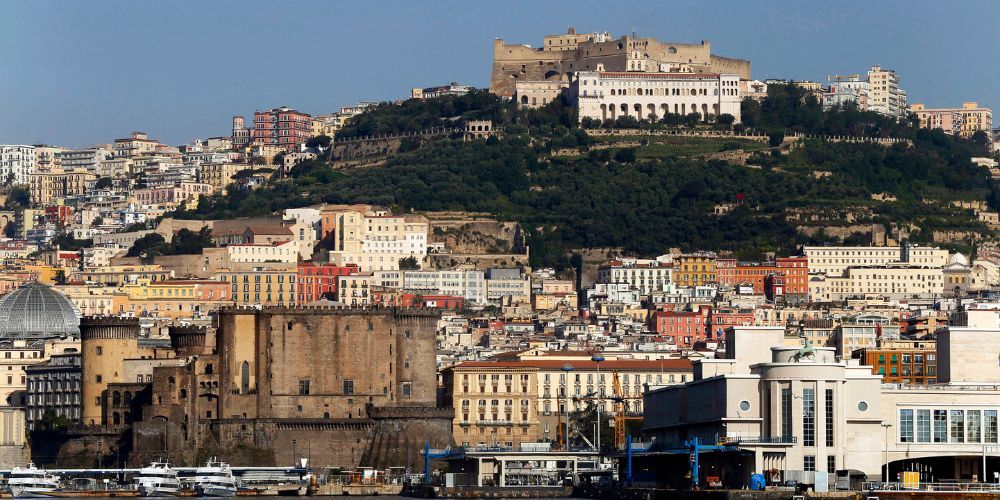
San Martino and Castel Sant'Elmo, view from the sea
Our tour to discover what to do in two days in Naples therefore starts from the top. For once, in fact, we reverse the classic itinerary of the "new city" (Naples derives from the Greek neapolis, which by definition makes it an ever-new city) and, leaving our luggage, we begin the visit from the highest point of the Vomero district, where Castel SantʼElmo and the Certosa di San Martino stand out in harmony and from whose terraces you can admire a view that takes your breath away. Vomero, among other things, is one of the neighborhoods where we recommend you stay if you are looking for more tranquility than the vibrant chaos of the Historic Centre.
The descent towards the sea is now possible with various means, all quite fast, but a touch of exclusivity is given by the San Martino pedamentina, the most beautiful of the pedestrian streets that unite the various levels of the city. Naples is in fact a vertical city, inhabited in layers (and therefore densely populated) and this characteristic makes it compact when viewed from above, as if it were enclosed in an embrace. We will end the first day in the historic centre, the largest in Europe, far from being just an open-air museum because it is alive and pulsating with so many activities.
The second day in Naples we begin with the culture of MANN, considered among the most important archaeological museums in the world and the best museums in Naples for the unique collections of the excavations of Pompeii and other Vesuvian and Phlegraean sites. Then, still walking, we enter the parlor of Piazza Plebiscito, the Galleria Umberto I and Borgo Marinari, until we go down to... the cellar. Yes, because there is an underground Naples which has hidden part of its history in the tuff. Returning to see the stars again, we end with the seafront that leads to Mergellina and, from here, we return for a moment again to climb upwards.
Day 1, the morning in Vomero district
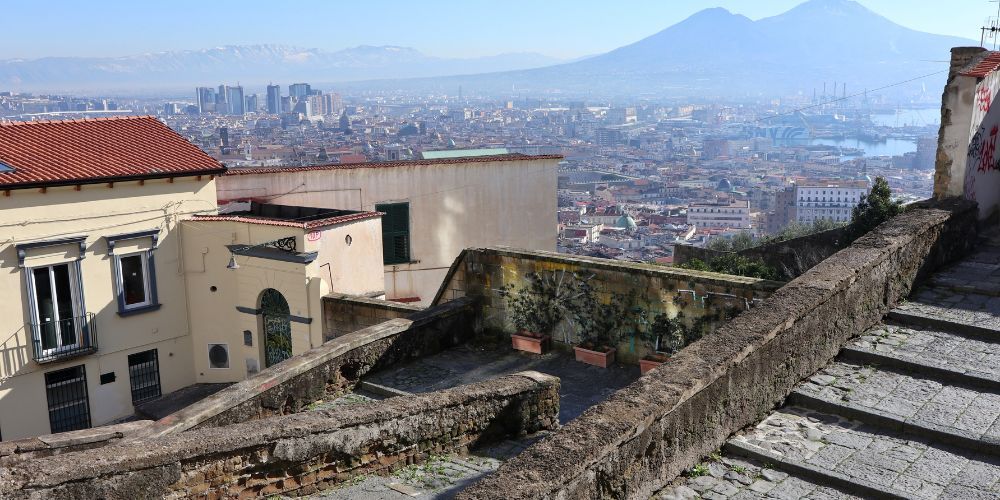
Pedamentina di San Martino
To go up to San Martino there are cable railways, the one that starts from Montesanto ‒ in the heart of the Spanish quarters ‒ arrives near Castel SantʼElmo, but also the central funicular that takes you from via Roma (in front of Galleria Umberto I) and that of Chiaia from Piazza Amedeo they go up towards Vomero and, after a short walk, allow you to reach the famous San Martino's terrace.
Here the first thing to do is to let your gaze guide you. You can see the entire city and in the middle, clearly visible, Spaccanapoli, the main artery of the historic center which encloses the greater and lower decumani, with on the right the imposing monastery of Santa Chiara with its green roof and marvelous majolica cloister. In the background the skyline of the Business Center under the ever-present care of Vesuvius. Once your eyes have been gratified, you have time to visit both the Certosa di San Martino with its Museum and the fortress of SantʼElmo, dating back to the 13th century and now houses the Museum of the Twentieth Century.
After the visits it's time to "dive" into the bustle of the alleys of Naples and then go down from Vomero, with the funiculars of course but also... on foot! Oh yes, because a city with millennia of history behind it had to invent a way to unite its layers and so here is the advice that will make your Neapolitan experience unique: the pedamentina of San Martino. There are 414 steps and stairways, to large and walkable basalts that lead - among fabulous glimpses! ‒ up to Corso Vittorio Emanuele. From here the Montesanto stairs to reach Pignasecca and, after passing via Toledo, the tour of what to do in Naples in two days dives into Spaccanapoli, where you saw it from above.
Day 1, the afternoon in Spaccanapoli
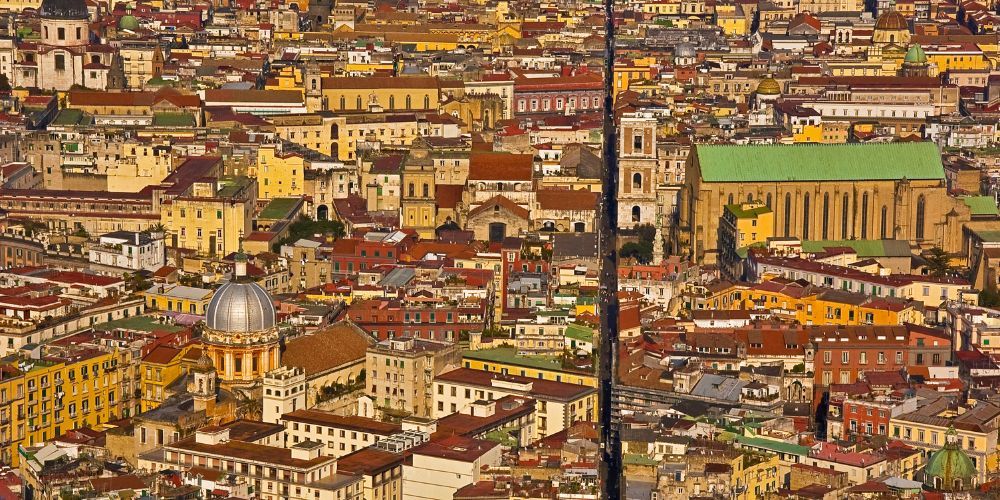
Spaccanapoli and, on right, Santa Chiara's monastry
First of all it's time to eat something, and what better place than the historic center of Naples to taste its rich street food accessible to all budgets. The land and sea "cuppettielli" offer amazing fried foods, from crocché to zeppole and fried pasta to typical fried fish. Those who love dessert will find sfogliate, babà and pastiere. And then there is his majesty the pizza, here in the historic center of Naples there are the most famous and historic pizzerias, which offer classic and contemporary ones. The only difficulty was finding a place!
You are in the largest historic center in the world, protected by UNESCO. The orthogonal scheme of the Greek colonists dates back to the 6th century BC, then in Roman times the three decumani that we still know today were redefined, with the maze of hinges which, in practice, has constituted the backbone of the city for almost 2,700 years! Spaccanapoli starts from the beautiful Piazza del Gesù, with its two places of worship: the church of Gesù Nuovo, a majestic expression of Neapolitan baroque, and the much-loved monastery of Santa Chiara, destroyed during the Second World War in 1943 and now rebuilt.
From Piazza del Gesù you take via Benedetto Croce (where the philosopher lived at number 12 and today there is the Italian Institute of Historical Studies) and you arrive in another square: San Domenico Maggiore. Another large church of which, however, the apse part can be seen here. You cannot miss a visit to the Sansevero Chapel near the square and, if you want to be amazed again, there is one of the greatest wonders of modern art here: the Veiled Christ by the sculptor Giuseppe Sanmartino. Continuing along Spaccanapoli, which now takes the name of via San Biagio dei Librai, you arrive at the perpendicular via San Gregorio Armeno, famous for its nativity and artisan tradition, active all year round in forging shepherds and Christmas figurines.
Via San Biagio dei Librai flows into via Duomo, where there is the cathedral and the sumptuous treasure room of San Gennaro, protector of the city, who three times a year celebrates the miracle of liquefaction of his blood. You can then go back along the other decumanus known as via dei Tribunali, to admire the beautiful churches of San Paolo Maggiore in Piazza San Gaetano (this was the Greek agora) and the basilica of San Lorenzo Maggiore, where Petrarca stayed and legend says that Boccaccio met his muse Fiammetta. A gem on Via Tribunali is the Capuzzelle church, where the cult of the "beggarly souls" is still alive, which believers took care of in exchange for benign protection.
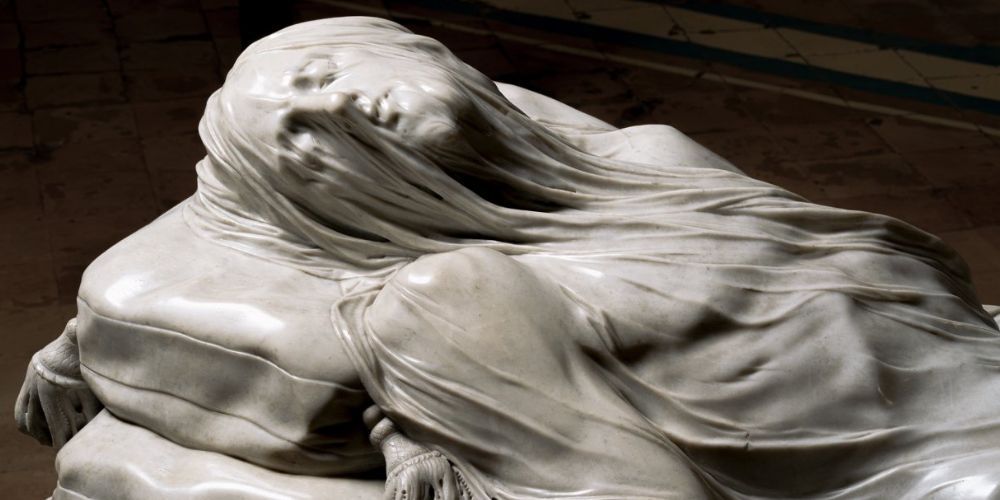
Cristo Velato
The Veiled Christ is the most famous nasterpiece inside the Chapel of the Prince of Sansevero, Raimondo di Sangro, but inside there are other masterpiece statues, such as the 10 dedicated to the virtues of the soul. Among these we only mention Modesty and Disillusionment for their artistic excellence.
Visit the Sansevero CheapelDay 1, the evening in PortʼAlba and Piazza Bellini
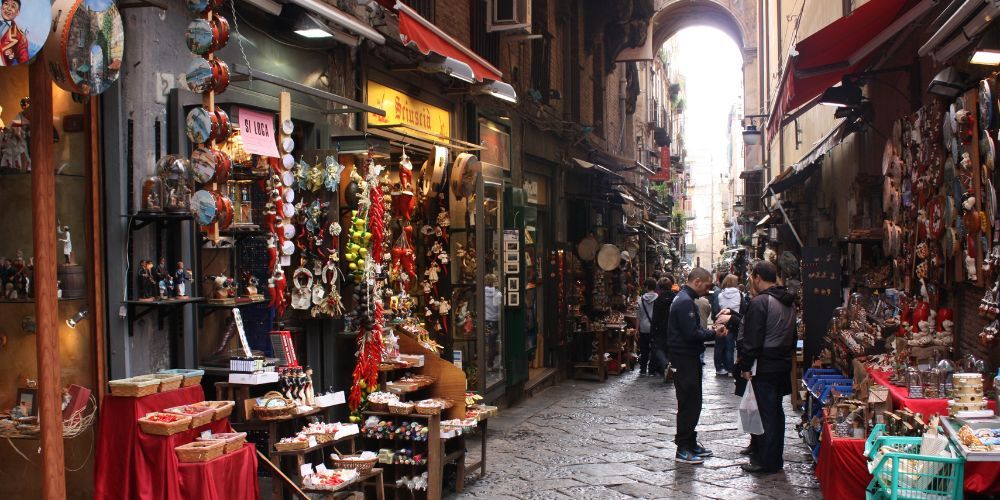
San Gregorio Armeno
The ancient center of Naples is not only history and tradition, but also the living and pulsating culture of the Universities which are still present here with their departments and libraries. The “Federico II” University complex goes up the entire Via Mezzocannone up to Piazza San Domenica Maggiore, but all around there are also the Conservatory of San Pietro Majella and the Academy of Fine Arts in Via Costantinopoli. Frequented by students, even those who live there outside, the historic center of Naples is therefore lively and crowded in the evening, with many clubs, so it's a good idea to end your first Neapolitan day here.
Piazza Bellini is one of the cult places of Neapolitan nightlife. It is a small square, the oldest in which remains of the decumani were found. It acts as a crossroads between Via Costantinopoli of the artists, Via San Sebastiano of the musicians (for the many instrument shops) and PortʼAlba, the bookshop street that opens onto Piazza Dante and therefore Via Toledo. The Antica Pizzeria PortʼAlba is a historic restaurant, the sign lists the year of foundation as 1738, that is a century and a half before the first pizza dedicated to Queen Margherita was codified! But when it comes to where to dine you're spoiled for choice.
What to do for two days in Naples: Day 2, morning
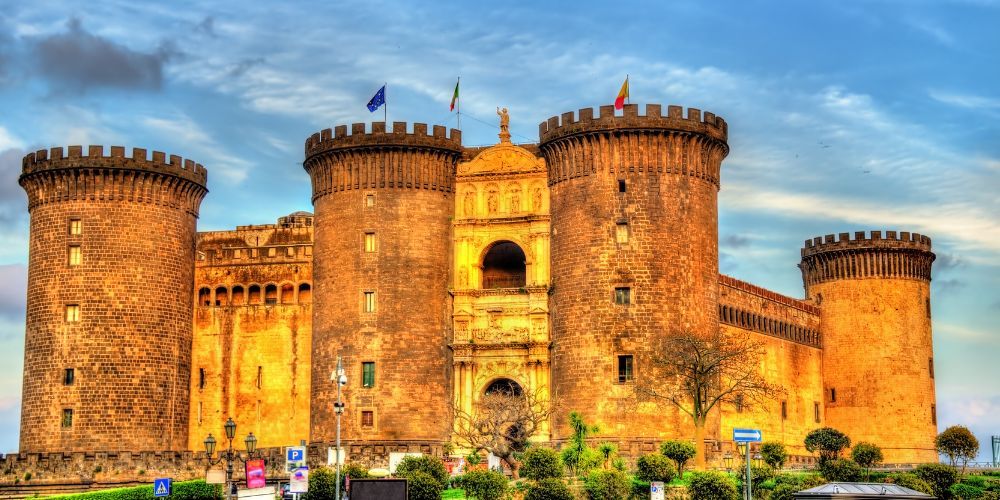
The Maschio Angioino Castle
To decide what to do on the second day in Naples, the advice is to start right where we left off the night before. In fact, from Piazza Dante, after a fleeting tazzulella eʼ café, it is a step away from MANN - the National Archaeological Museum of Naples - which for Neapolitans is simply the Museum, whose rich collections (Borgia, Farnese, Egyptian) and the collection of finds found in the excavations of Pompeii, Herculaneum and Cuma make it a unique excellence in the world.
Once out of the MANN it's time for a walk and what better road than via Toledo which is just a hundred meters away. It is the street of the Neapolitans' "struscio", the promenade, sung by Renato Carosone and today a shopping street, which leads straight to Piazza Plebiscito. Of course, a detour into the Umberto I Gallery is a must, which opens onto the San Carlo theater and Piazza Municipio where the majestic Maschio Angioino stands. The castle is today not just a place to visit, but still plays an active part in city life, given that the meetings of the Naples City Council take place in the Hall of the Barons.
We finally enter Piazza del Plebiscito, the living room of the city with its elegant cafes and the surrounding area represented by the Royal Palace (now it hosts the National Library) and the Basilica of San Francesco da Paola with its great nineteenth-century colonnade. And looking up you see the Certosa di San Martino and Castel SantʼElmo again, where you were on the first day, and for this reason too it is an advantage to have started the tour of Naples from above, because the familiarity of the places already seen will strengthen the feeling of having embraced the city and got to know it a little better.
Close to the square there is also the Galleria Borbonica, one of the best entrances to underground Naples, once used by the prefecture as a depot for seized vehicles. Another access to the city underground is in Piazza San Gaetano, in the historic centre, where there is an itinerary of tunnels and cisterns which best explains the historical structure of Naples and allows you to take a journey through time spanning 2400 years.
Day 2, the afternoon in Chiaia District
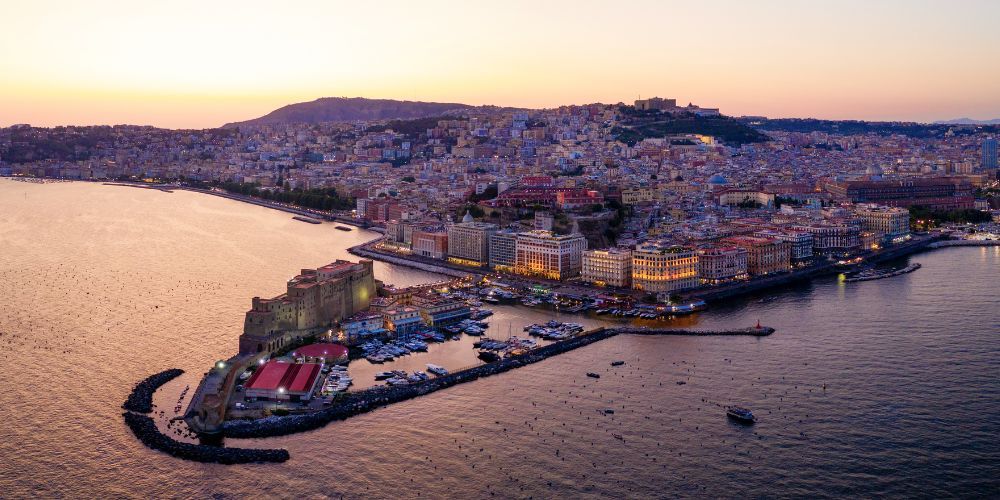
Borgo Marinari with Castel dell'Ovo
Leaving Piazza Plebiscito you reach the sea. Both taking Santa Lucia and continuing towards Via Partenope, you have the Naples seafront and the enchanting Borgo Marinari in front of you. Before finding out, however, it is the case of a refreshment and here there is a flourishing of places that pride themselves on a dream location, magnified since the street was made pedestrian.
After lunch we enter the Borgo, built on the islet of Megaride and joined to the city by a bridge. Here stands Castel dell'Ovo, the splendid manor on the sea which seems to be the oldest nucleus of Naples (the "egg" sung by Virgil poet and from which the city was born was deposed by the mermaid Parthenope), once a fortress but also a prison, from especially visit the cannon terrace, the highest and most panoramic part.
After Borgo Marinari and reached Piazza Vittoria you have the Caracciolo seafront in front of you, and here too the amazement beats the desire for knowledge. The advice is to follow it entirely, perhaps also partly internally, given that the green lung of the Chiaia Riviera runs parallel to the seafront and, towards the end of this, the further park of Villa Pignatelli. Now you are at Mergellina, a romantic area but not without fond memories: here there is in fact the Vergiliano Park, which houses the remains of the Latin poet Virgil and, since 1939, those of Giacomo Leopardi. Post scriptum for non-Neapolitans: the Vergiliano Park is not to be confused with the Virgiliano Park, which is a green lung of the Posillipo district.
Day 2, evening in Posillipo
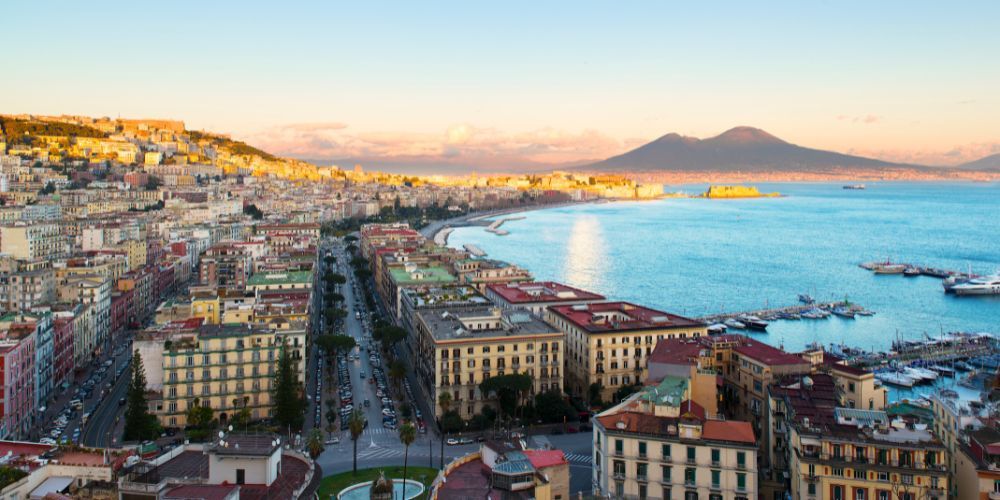
Naples view from Sant'Antonio a Posillipo
We are now at the sunset of the second Neapolitan day and instinct tells us that we need to go back... up! In Mergellina there is in fact a cable railway which, at the first stop, arrives at the little church of Sant'Antonio a Posillipo, in the heart of the district of the same name.
Church aside, here is the most iconic terrace in all of Naples, the most beautiful and famous view of the city which overlooks the gulf like an amphitheater, as if it wanted to embrace us, kiss us. Ultimately, Vesuvius reflecting in the sea does not arouse any other idea than lips close to a kiss. Dinner in one of the restaurants in Mergellina cannot be more nice.
About the author
Written on 22/01/2024


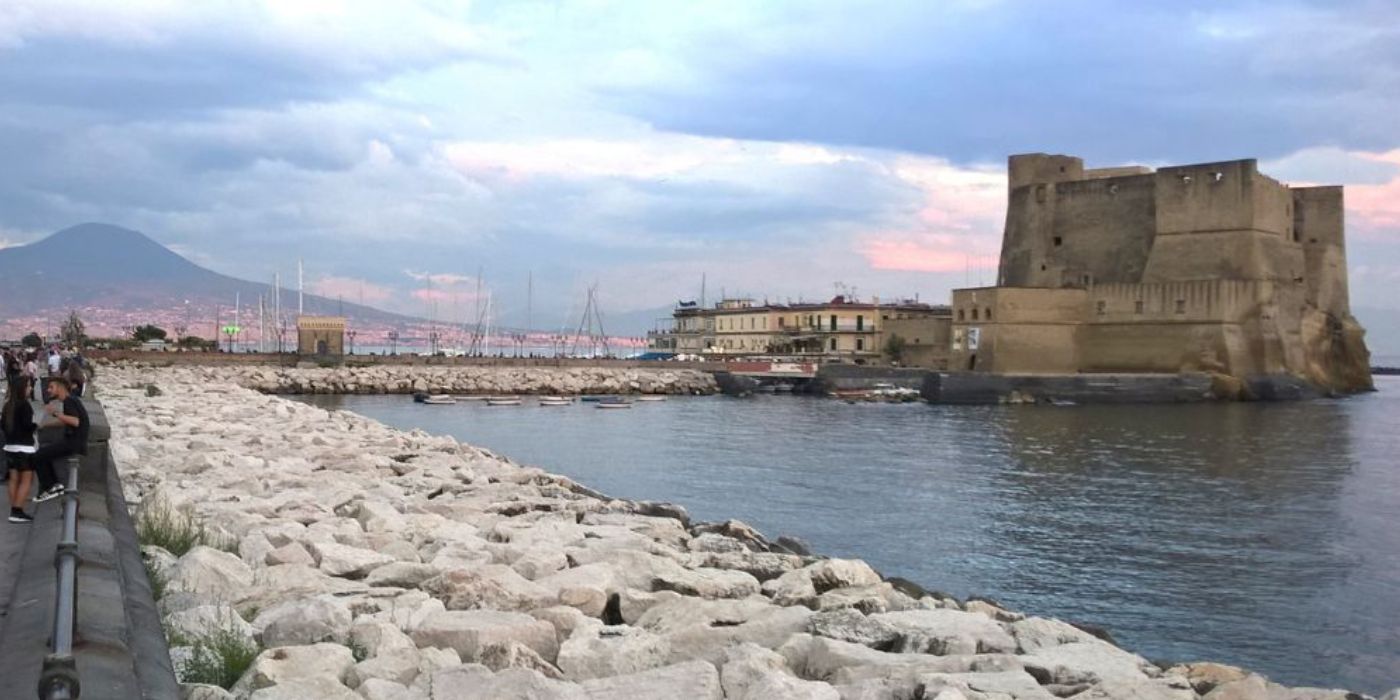

Antonio Angione
A short but intense immersion to discover the city under Vesuvius. Here's what you can do in two days in Naples. Discover with us